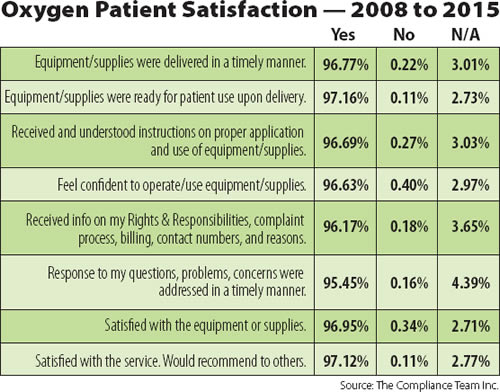State of Satisfaction
The State of Oxygen Satisfaction
New feature from HMEB: Data from accrediting organization The Compliance Team sheds some light on key pieces of patient data.
- By David Kopf
- Mar 01, 2015
Outcomes are everything when it comes to providing healthcare, and reporting those outcomes is critical. One of the more “softer” types of patient outcomes data is patient satisfaction. That said, satisfaction is critical and there is a way to generate hard data for that soft subject that can yield worthwhile insights into patient care performance.
Recording patient satisfaction is something that providers are already recording. CMS requires accredited providers to document patient satisfaction as part of their accreditation standards. If providers neglect to do so, it can cost them points on their accreditation score. When a provider is accredited, it must continue to meet or exceed CMS quality standards, and to ensure that happens, every accrediting organization (AO) has to have a standard that relates to a provider collecting patient satisfaction and complaint data from their customers.
CMS doesn’t dictate the measures providers should use to collect the data or what questions to ask patients. In fact, CMS basically looks for a pass/fail grade given by the provider’s AO regarding the provider’s overall patient satisfaction collection standards. Therefore, each AO differs in its standards of patient satisfaction data collection.
Data as a Valuable Tool
While providers are reporting patient satisfaction, the question is, are they recording it and trying to use it as a tool to sharpen their performance and differentiate their services to their referral partners? Beyond just tracking their internal performance, what about comparing it to other providers’ data or national trends?
One Accrediting Organization that is helping providers accomplish that is The Compliance Team Inc. The AO has all of its provider clients use the same tool to collect their customer satisfaction data. This funnels the information they convey regarding patient satisfaction into a database, where it is compared against thousands of other providers. The result: a nationwide patient satisfaction benchmarking resource.
“Providers in our database have the capability to benchmark themselves against the thousands of providers in the database,” says TCT Founder and President Sandra Canally, RN.
To that end, TCT expanded enrollment for its web-based patient satisfaction reporting and benchmarking service last year to include all DMEPOS provider organizations whether accredited by The Compliance Team or by another Medicare-approved accreditation organization.
To date, the firm has collected, aggregated and benchmarked more than 1.3 million patient satisfaction surveys while garnering 10 million standardized data points from providers based in all 50 states, Puerto Rico and the US Virgin Islands, according to Canally.
Enrollees of the online benchmarking service are given on-line access to standardized DMEPOS questionnaires that are utilized to conduct follow-up patient satisfaction phone surveys. The results are then uploaded to The Compliance Team’s national database for aggregation and peer benchmarking.

This Month’s Data: Oxygen
To give providers an idea of some national satisfaction trends, The Compliance Team is working with HME Business to provide regular updates on its nationwide data. For this month, we’ve picked a key care category: Oxygen.
At the outset, it should be clear from the chart, “Oxygen Patient Satisfaction — 2008 to 2015,” that nearly all patients are satisfied with the services, care and equipment they are getting. But that is not the important data, according to Canally. What’s important is to examine the negative numbers. Providers need to understand who wasn’t satisfied and why, because those are the outliers that will help them improve their businesses. For instance, looking at the chart, let’s say a provider generally does well in delivering oxygen equipment, but had 10 patients over the past two years that did not think that their equipment was delivered in a timely manner — that’s 10 soured patients, possibly 10 soured referral partners, and a fairly decent amount of bad word-of-mouth.
A provider can compare its business to the national trends and see where it might be falling off, and when. Let’s take the first the first item on the chart as an example. If a provider notices delivery satisfaction is down, it can narrow the time constraints to start seeing why so that it can start correcting the problems.
“Were they short delivery personnel on a given day; did they have an incorrect address,” Canally explains. “There are all sorts of scenarios that could come into play. … It’s all about process.”
But chances are, many of the delivery issues are related to intake, and that is a place that providers can improve.
“The DME receives an order, maybe a patient is being discharged, and the oxygen needs to be waiting at the patient’s home when the patient arrives,” she explains. “… We look at things operationally, so in my mind it relates to [providers’] intake process. What exactly happened during the intake process? Is it a problem between intake and disbursement from the warehouse?” That ability to pinpoint areas of improvement will become critical in the future of healthcare, and will be a key asset for providers to help them improve and reinforce their reputations for reliability, dependability and service. Expect more TCT satisfaction data in future issues.
This article originally appeared in the March 2015 Respiratory Management issue of HME Business.
About the Author
David Kopf is the Publisher HME Business, DME Pharmacy and Mobility Management magazines. He was Executive Editor of HME Business and DME Pharmacy from 2008 to 2023. Follow him on LinkedIn at linkedin.com/in/dkopf/ and on Twitter at @postacutenews.